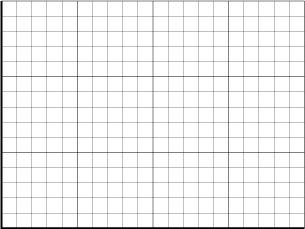Module 5—Circular Motion
Problem 2
How is inward force related to radius?
Procedure
Use the Circular Motion: Horizontal simulation.
- Set the mass to 1.0 kg.
- Set the initial velocity to 10 m/s.
 Module 5: Lesson 1 Assignment
Module 5: Lesson 1 Assignment
Remember to submit the answers to LAB 1, LAB 2, and LAB 3 to your teacher as part of your Module 5: Lesson 1 Assignment.
Observations and Analysis
LAB 1. Run the simulation, and adjust the radius to the values indicated in the following table. Record the inward force (tension).
| Radius (m) | Inward Force (tension) (N) |
0.5 |
|
| 1.0 | |
| 2.0 | |
| 3.0 | |
| 4.0 | |
| 5.0 | |
| 6.0 | |
| 8.0 | |
| 10.0 |
LAB 2. Use the data from the table in LAB 1. Sketch the graph in the space provided below. (Note: You may enter the data into a spreadsheet and use the spreadsheet’s graphing capabilities.)
Radius vs. Inward Force
LAB 3. Compare your graph to the table in LAB 1, and state the relationship between the inward force and the radius. Substitute the term Fc for y and the term r for x.
Problem 3
How is inward force related to mass?
Procedure
Use the Circular Motion: Horizontal simulation.
- Set the radius to 2.0 m.
- Set the initial velocity to 5.0 m/s.
Module 5: Lesson 1 Assignment
Remember to submit the answers to LAB 4, LAB 5, and LAB 6 to your teacher as part of your Module 5: Lesson 1 Assignment.
Observations and Analysis
LAB 4. Run the simulation, and adjust the mass to the values indicated in the table below. Record the inward force (tension).
| Mass (kg) | Inward Force (tension) (N) |
| 1.0 | |
| 2.0 | |
| 3.0 | |
| 4.0 | |
| 5.0 |
LAB 5. Use the data from LAB 4. Sketch the graph in the space provided below. (Note: You may enter the data into a spreadsheet and use the spreadsheet’s graphing capabilities.)
Mass vs. Inward Force
LAB 6. Compare your graph to the table in LAB 4 and state the relationship between the inward force and mass. Substitute the term Fc for y and the term m for x.
![]()
 Module 5: Lesson 1 Assignment
Module 5: Lesson 1 Assignment
Remember to submit the answers to LAB 7, LAB 8, and LAB 9 to your teacher as part of your Module 5: Lesson 1 Assignment.
Conclusion
LAB 7. Combine your answers from SC 7, LAB 3, and LAB 6 to produce a mathematical expression for the inward force as a function of mass, velocity, and radius.
![]()
LAB 8. Show that this expression is dimensionally correct according to F = ma. In other words, the units for the equation in LAB 8 should be consistent with the fact that 1 N = 1 kg•m/s2.
LAB 9. Derive an equation for the acceleration acting on an object moving along a circular path in a horizontal plane. (Equate Newton’s second law, F = ma, to your expression for the inward force from LAB 8.) Find this equation on the Physics 30 Data Booklet. You can find it on the Alberta Education website.
 Self-Check
Self-Check
SC 8. Use the Circular Motion: Horizontal simulation to confirm the direction of the acceleration vector.
- Set the mass at 1.0 kg and the initial velocity at 11.0 m/s.
- Select the “Vectors” display button (
 ) near the top of the window. The acceleration vector appears in blue, and the velocity vector appears in pink.
) near the top of the window. The acceleration vector appears in blue, and the velocity vector appears in pink.
- Play the simulation to see the directions change.
Describe the direction of the following:
- the acceleration vector
- the velocity vector
 Self-Check Answers
Self-Check Answers
SC 8.
- The acceleration vector is always directed towards the centre of the circle.
- The velocity vector is always perpendicular to the acceleration vector (tangent to the circle) and oriented in the direction of rotation.